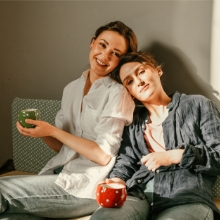Did you know that 1 in 5 Canadians experience a mental health issue or a mental illness? That’s according to the Canadian Mental Health Association (CMHA).
During Mental Health Week, CMHA shows us how we can express and nurture mental health care. Art, photos, music, sounds, dance, movement, nature can all support improving mental health.
Mental health challenges also affect millions of people worldwide. There is so much work to do to make it a global priority. In partnership with Unsinkable, I had the opportunity to connect with Megan Kee, one of their community champions. Megan is using the power of art to make a meaningful difference.
She is the Founder and Director of Twentytwenty Arts, a non-profit producing social impact art projects. She is also the Founder and Creative Director of Twentytwenty Design. It’s a design and marketing agency that works with charities, non-profits, and social enterprises.
Harnessing art is an effective way to tell stories and connect people to a common cause. Here is more on my conversation with Megan:
Q: Mental health affects many of our lives, or the lives of our loved ones, in different ways. How has mental health challenged your life?
A: Well, the short version is that I live with bipolar disorder. It has caused challenges throughout my life. The long version is more complicated:
I began experiencing intense waves of emotion at the age of 15. Of course, that is pretty standard for a teenager. But for me, those intense waves of emotion never went away. I first started to suspect that I was bipolar when I was in my early 20s. But I was officially diagnosed only when I was 31.
Before my diagnosis, I went through a dizzying array of ups and downs, from intense feelings of connectedness to overwhelming feelings of despair and hopelessness. Amid my emotional chaos, my older brother Jay died from an overdose. It shook me to my core. I had never experienced a loss like that, and I didn’t know how to handle it. I had daily panic attacks. I cried at my desk, and had brief moments of suicidal ideation. But after 7 months of non-stop misery, the fog started to lift.
In the moments of silence, I started to realize that my brother would have wanted me to be happy. I had spent so much of the last 7 months thinking about his death that I forgot to think about his life. Over time, I started to have gratitude for the time I had with him instead of resenting the time I had lost.
That mindset shift changed everything.
I wanted to do everything I could for my mental health because I knew Jay would have wanted me to be happy. So, I started eating better, exercising daily, meditating, journaling, doing yoga, and taking vitamins. I started experimenting with my environment and following my intuition. I made time for silence, and stopped worrying about what I could not control.
These changes made me who I am today. I am more resilient than I have ever been. I still struggle with the highs and the lows, but with some key lifestyle changes (and therapy), they are much less severe.
Q: Why did you decide to create Twentytwenty Arts?
A: Twentytwenty Arts was sort of an accident. When I first started my career in the arts in 2013, I never intended to start a non-profit organization. But after Jay died in May 2016, I realized that life was too short not to do something you believe in. So, I let go of the fear and started trying new things.
In 2018, I created the first iteration of Life on the Line – an exhibition of art throughout the Toronto TTC subway, with prints being sold in the TTC Shop. When we were planning this exhibit, I realized this fundraising would be more effective as an organization. This is how Twentytwenty Arts was born. Our last iteration of Life on the Line ran from October 7-10, 2022.
My goal with Twentytwenty Arts has been to create a tangible connection between art and social change. It has always made sense to me to use the power of art to inspire people towards action. The two go hand-in-hand.
Q: How do you believe art can support better mental health?
A: Art can be a powerful tool for both creators and viewers. For creators, art can be a tool for staying grounded in the present moment. A way to let go of control, focus on the process, and explore your emotions. For viewers, art can elicit joy, sadness, and a depth of emotion that words often have difficulty conveying.
Art is how we make sense of the world around us—it always has been. As far back as 64,000 years ago, when the oldest known cave paintings were created, human beings used image-making to understand the world around them. For this reason, art has been a significant part of every major political and cultural movement throughout history, and the mental health crisis is no different.
Q: What are you most proud of with Twentytwenty Arts?
A: The most impactful was Weathered, an overdose awareness campaign inspired by my brother. We asked anyone who had lost a loved one to an overdose to submit a photograph of their loved one’s shoes. The project coincided with Overdose Awareness Day and raised over $10,000 for Street Health’s Overdose Prevention Site.
The real impact of our projects are the conversations they start. During Weathered, I received multiple phone calls from mothers who had lost their children to an overdose and were eager to share their stories. As heart wrenching as it was, it really drove home the importance of creating space to allow people to share their stories and the stories of their loved ones.
Q: Tell us about your connection to Unsinkable.
When I wrote my story for Unsinkable, it was the first time I thoughtfully reflected on my journey. Not only was it a cathartic experience, but it gave me a deep appreciation for how far I have come. We can talk about mental health statistics all day long. What humanizes our experiences and showcases the real need for support is our stories.
Unsinkable provides a platform for people to see and be seen. They champion vulnerability, which gives readers an understanding of the subtlety and nuance of mental health experiences. I am so grateful for the role that Unsinkable has played, and continues to play, in my journey.
Q: When it comes to making mental health a priority, what do you believe still needs to happen?
A: Aside from providing enhanced social supports, we need to stop prioritizing money over people in organizations. So much pressure is put on employees to produce more, faster, and with less resources. I believe that we need to normalize companies meeting employees where they are, rather than the other way around.
I would like to thank Megan for her honesty and vulnerability. The unwavering hard work by non-profits, charities, and other grassroots organizations to make mental health a priority does not go unnoticed.
I hope Megan’s story inspired you. I also hope you’ll find ways to make mental health and well-being a priority, every day of the year.
If you or someone you know needs help, please reach out:




